D-Sat
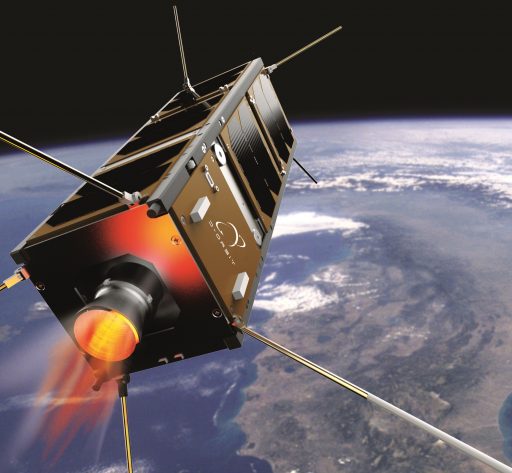
D-Sat is a 3U CubeSat built and operated by Italian Company D-Orbit to demonstrate D3, the D-Orbit Decommissioning Device – an active end-of-life re-entry solution for small satellite missions to mitigate the accumulation of space debris.
The growing population of space debris has become a strong concern and the increasing number of small satellite missions in the Low Earth Orbit regime over the coming years could cause an overcrowding issue if no mitigation is developed. To ensure safe and sustainable access to space, it will be necessary to stop the growth of non-operative defunct satellites by removing still-functional satellite from orbit at the end of their operational lives. Preventive debris removal can be enabled with an independent de/re-orbiting propulsion system, however such systems need to be compact to avoid adding to a satellite’s overall launch cost and must not interfere with a satellite’s primary mission.
The majority of the world’s space agencies are actively working to mitigate space debris either through guidelines or development of new systems for the deorbitation of satellites. In addition to government and agency-level efforts, the private sector has also started a number of initiatives on a commercial or private institutional basis to further the Technology Readiness Level for end-of-life disposal technologies.
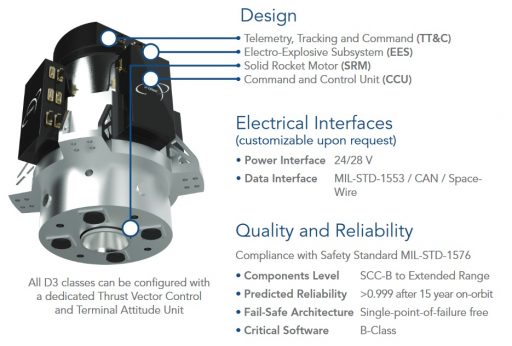
There are a number of different end-of-life deorbitation systems that can be classified as active and passive systems, active solutions being propulsive systems that slow a satellite down either through solid, liquid or electric propulsion to bring about either an immediate re-entry or a reduction in orbital altitude to speed up orbital decay from a period of years to a few months. Passive solutions that have received attention in recent years are drag brakes that can take different forms such as sails or balloons, and electromagnetic tethers which can speed up a satellite’s decay but require long-term operation.
D-Orbit, based in Como, Italy aims to commercialize a unique device for direct and controlled decommissioning for small satellite missions. D3 is a small, dedicated and independent decommissioning device using solid propulsion technology to provide retropropulsion for a targeted deorbit burn. The major advantage of such a device is that it works even if the satellite is no longer functional, it complies with NASA and ESA safety standards, it is single-point failure free with the exception of the motor, and it is scalable for use on a variety of satellite sizes and orbits.
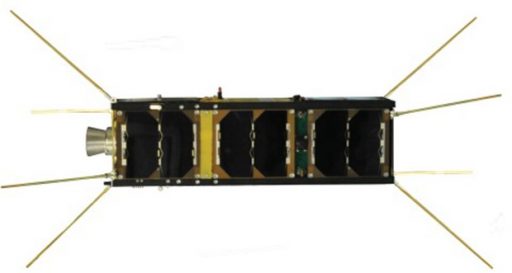
The D-Sat mission has the primary goal of testing the D3 deorbit device to demonstrate the maturity of the technology and advance to Technology Readiness Level 9. The device will be initiated after a two-month orbital mission dedicated to secondary objectives. It is the first CubeSat mission with a dedicated solid rocket motor for active deorbiting at the end of its mission.
D-Sat as a project was initiated in 2014 with initial funds from internal company investments. ESA provided funding to the project starting in December 2015 under the European Union’s Horizon 2020 research and innovation program.
The D-Sat spacecraft, 10 x 10 x 34 centimeters in size, weighs less than 4.5 Kilograms and uses an overall systems infrastructure focused on reliability to achieve mission success, employing a design that is single-point failure free which is rather rare in CubeSat missions.
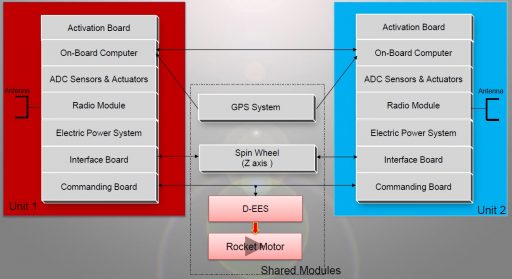
In architecture, D-Sat consists of two fully identical units known as Unit 1 and Unit 2, each comprising eight modules and are fully capable of handling all satellite operations. Typically, one unit will be in Master mode while the other is in a payload mode. The two units share a GPS system, spin wheel and the D3 deorbitation device located in the aft section of the spacecraft.
Per the normal mission plan, Unit 1 will be taking the function of satellite platform, providing housekeeping, attitude determination and control, energy management, onboard computing and communications. Unit 2 will act as slave for the duration of the orbital mission and take control for the decommissioning phase to provide a maneuver-stable attitude and conduct the deorbit maneuver. Both units have interfaces with the Electro Explosive System and can initiate the rocket motor, so that even if one unit becomes unavailable, the maneuver can still be executed.
Each of the satellite units contains an onboard computer board, one interface board, one radio module, S-Band antenna, attitude control unit, electric power system, commanding board, camera and atmospheric analyzer board.
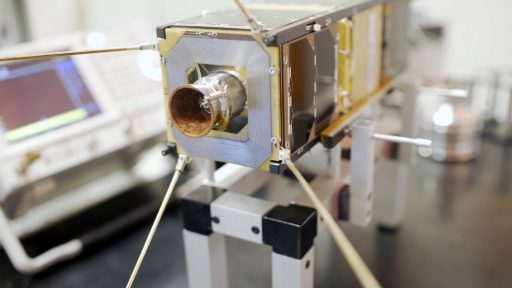
The D3 Deorbit System, also called the Electro Explosive Subsystem within the framework of D-Sat, comprises two major components – the SRM (Solid Rocket Motor) consisting of a casing and the solid propellant material, and the EED (Electro Explosive Device) in charge of providing the ignition source for the SRM. The system complies with the MIL-STD-1576 standard for space application with focus on safety; several inhibits are part of the system to avoid an unintentional ignition of the device – on the ground, during launch or in orbit. Three of the inhibits are controlled by telecommand and one is based on the pyrotechnic chain status.
The SRM features a cartridged motor case where the propellant grain is case-bonded to a steel cartridge surrounded by the rocket motor housing. This allows the propellant cartridge to be handled and transported separately from the nozzle and motor housing.
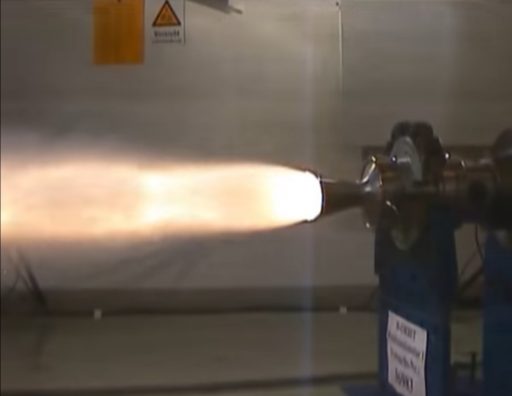
The Solid Rocket Motor is 97 millimeters in diameter, 122mm long and holds 0.3 Kilograms of non-metalized solid propellant with a total weight of the loaded motor around 0.9 Kilograms. The SRM has a nozzle diameter of 7.5 millimeters and an expansion ratio of 20.
Its nominal burn time is 3.2 seconds with a maximum thrust of 450 Newtons at the motor’s upper operational temperature of +71°C and a minimum delivered impulse of 740Ns at the lowest operational temperature of -34°C. SRM reaches an impulse of 2613m/s and the chamber pressure should be no higher than 70 bar.
Qualification testing with four motors showed the SRM operates between a pressure of 47 and 64 bar depending on its temperature with a maximum thrust of 483 (+/-21) Newton with a fluctuation in burn duration from 2.6 to 3.6 seconds for the lowest and higher operational temperatures. All tests showed excellent ignition reliability and very short ignition delay as well as a good repeatability of the impulse bit delivered within the operational temperature envelope, further building confidence in the D3 design.
https://www.youtube.com/watch?v=2RcgEJfstZU
As part of the D-Sat mission, the D3 system will sit idle for two months while the satellite completes secondary mission objectives, also allowing engineers to study the system during prolonged exposure to space, looking at the effect of radiation and the actual temperature environment experienced in Low Earth Orbit. Ignition of the SRM will be triggered via ground command at a precisely planned location to control the re-entry location in order to demonstrate a targeted deorbit capability with re-entry/splashdown in a remote location over the North Atlantic.
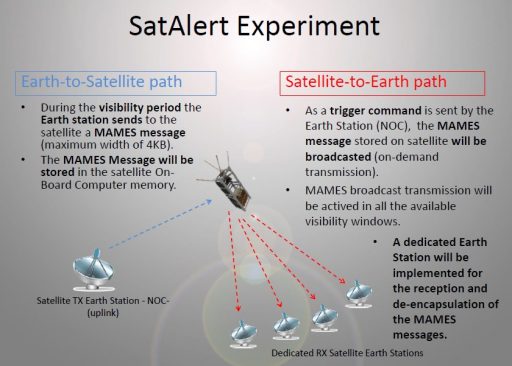
In what is known as the cruise phase – that is D-Sat’s two months in free flight – the satellite will carry out the SatAlert demonstration and during re-entry, an atmospheric analyzer will be in action to collect rare measurements in the mesosphere and an innovative system will test a warning architecture for falling space debris.
SatAlert is an in-orbit validation of the Multiple Alert Message Encapsulation (MAMES) emergency protocol – a standardized protocol for the delivery of alert messages to the population in the event of a disaster. MAMES is a multiple alert message encapsulation protocol for alert messages transport over satellite links suitable for differently formatted alert messages such as CAP (Common Alert Protocol), unstructured text, image, paging protocols, DeCAS messages. This will enable a maximum of people to be reached and reduce potentially tragic consequences of a disaster.
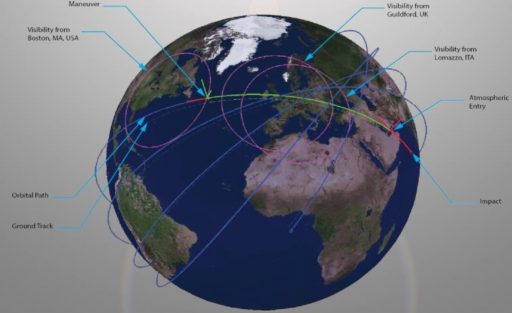
D-Sat will collect MAMES messages from a ground station, store them on board and re-broadcast them to national public safety entities upon receiving a request. Two ground stations, one in Florence and one at D-Orbit’s facility in Lomazzo, will be involved in the experiment. Lomazzo will generate and transmit the MAMES message and it will also receive the re-broadcast and decapsulate the message. Florence will only be in a receiving role.
DeCAS, the Debris Collision Alerting System, is a small-sized device that is dormant while a spacecraft is in orbit and automatically activates at the point of fragmentation when the craft re-enters the atmosphere. Once active, DeCAS automatically determines its position and begins broadcasting to inform air traffic and population of the actual impact area of space debris with some warning lead time. At present, uncontrolled re-entries can only be forecast with limited accuracy and no warnings can be issued beyond very broad zones where orbital decay may occur with margins of several minutes to several hours.
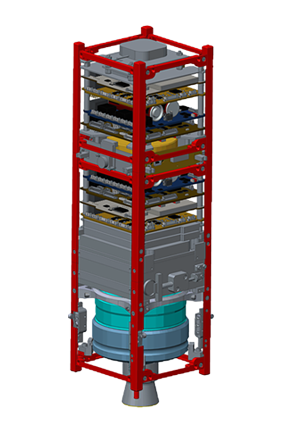
DeCAS can warn of the imminent fall of space debris from controlled and uncontrolled re-entries as well as late-stage launch vehicle failures. With D-Sat, DeCAS will make its first space-based demonstration, using a simulated trigger to mimic an uncontrolled re-entry upon which DeCAS will generate a message towards the ground with the necessary parameters to define the simulated debris footprint that allows ground-based programs to calculate the time and location of potential impacts. DeCAS and MAMES will also operate in unison to verify using the emergency protocol for the transmission of DeCAS messages that allows their validation and authenticity.
DAA (D-Orbit Atmosphere Analyzer) is an in-house development by D-Orbit to measure atmospheric parameters during re-entry and transmit them to specific fixed or mobile ground stations. Data from the instrument will be of use for insurance companies, weather agencies and telecommunications providers seeking in-situ measurements of the Mesosphere and Lower Thermosphere between 150 and 80 Kilometers in altitude (where destructive re-entry has not yet started). Parameters captured by DAA are temperature, GPS position and signal variation and magnetic field. The 80-150km region is the least studied region of the atmosphere because it can not be reached with satellites or high-altitude balloons.
